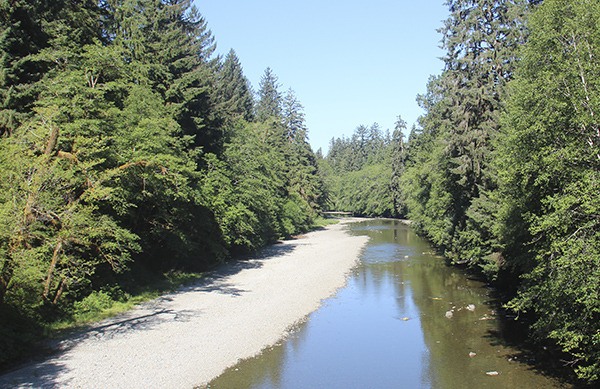State fishery managers are taking steps to protect fish that are affected by drought conditions, and are asking anglers to do their part as well.
The Washington Department of Fish and Wildlife (WDFW) has restricted some fishing opportunities and will need to restrict others. In addition, the department will likely release some hatchery fish early and transport salmon and steelhead that are unable to make it upstream to spawning grounds.
This year’s low snowpack and warm weather have raised water temperatures and reduced flows in rivers and streams across the state to levels that can be lethal to fish, said Teresa Scott, WDFW’s drought coordinator.
“We’re seeing some really challenging conditions for fish in streams and rivers, especially for this early in the summer,” Scott said.
WDFW already has curtailed fishing on a section of the Sol Duc River to protect returning chinook. The department also closed fishing for spring chinook on the Grande Ronde River due to low river flows. Additional closures or restrictions will be posted on the department’s webpage, said Craig Burley, WDFW fish program manager.
In the meantime, Burley suggested anglers should limit fishing to the morning hours to reduce stress on fish, immediately return fish to be released back to the water, and land fish quickly.
“These few precautionary steps will help protect fish during drought conditions,” Burley said.
Higher water temperatures and low stream flows also are creating problems at WDFW’s fish hatcheries. Warm water temperatures at hatcheries make fish more susceptible to disease and stress, which means fewer fish survive.
WDFW has prepared contingency plans for operating fish hatcheries most vulnerable to drought conditions. Those plans, which can vary for each facility, include steps ranging from pumping water from deep wells to trucking returning salmon to hatchery facilities.
The department is also responding to cases in which salmon migrating upstream have been stranded because of river conditions, Scott said.
Scott urged the public to report sightings stranded fish, or other wildlife distressed by drought, by visiting the department’s website athttp://wdfw.wa.gov/conservation/drought/. She also asked people to refrain from building recreational rock dams in streams, creating barriers for migrating fish.
Drought conditions harming fish and wildlife,
disrupting some fisheries
OLYMPIA – State fishery managers are taking steps to protect fish that are affected by drought conditions, and are asking anglers to do their part as well.
The Washington Department of Fish and Wildlife (WDFW) has restricted some fishing opportunities and will need to restrict others. In addition, the department will likely release some hatchery fish early and transport salmon and steelhead that are unable to make it upstream to spawning grounds.
This year’s low snowpack and warm weather have raised water temperatures and reduced flows in rivers and streams across the state to levels that can be lethal to fish, said Teresa Scott, WDFW’s drought coordinator.
“We’re seeing some really challenging conditions for fish in streams and rivers, especially for this early in the summer,” Scott said.
WDFW already has curtailed fishing on a section of the Sol Duc River to protect returning chinook. The department also closed fishing for spring chinook on the Grande Ronde River due to low river flows. Additional closures or restrictions will be posted on the department’s webpage, said Craig Burley, WDFW fish program manager.
In the meantime, Burley suggested anglers should limit fishing to the morning hours to reduce stress on fish, immediately return fish to be released back to the water, and land fish quickly.
“These few precautionary steps will help protect fish during drought conditions,” Burley said.
Higher water temperatures and low stream flows also are creating problems at WDFW’s fish hatcheries. Warm water temperatures at hatcheries make fish more susceptible to disease and stress, which means fewer fish survive.
WDFW has prepared contingency plans for operating fish hatcheries most vulnerable to drought conditions. Those plans, which can vary for each facility, include steps ranging from pumping water from deep wells to trucking returning salmon to hatchery facilities.
The department is also responding to cases in which salmon migrating upstream have been stranded because of river conditions, Scott said.
Scott urged the public to report sightings stranded fish, or other wildlife distressed by drought, by visiting the department’s website athttp://wdfw.wa.gov/conservation/drought/. She also asked people to refrain from building recreational rock dams in streams, creating barriers for migrating fish.



